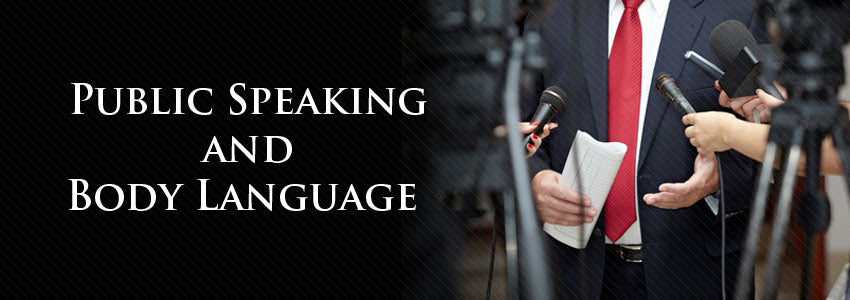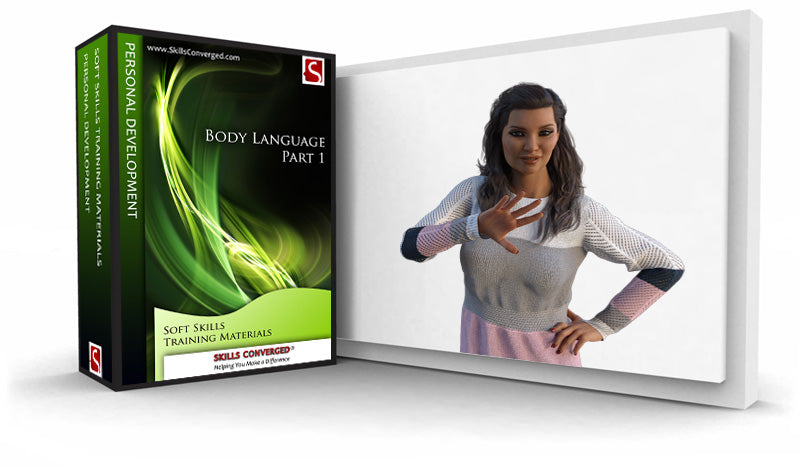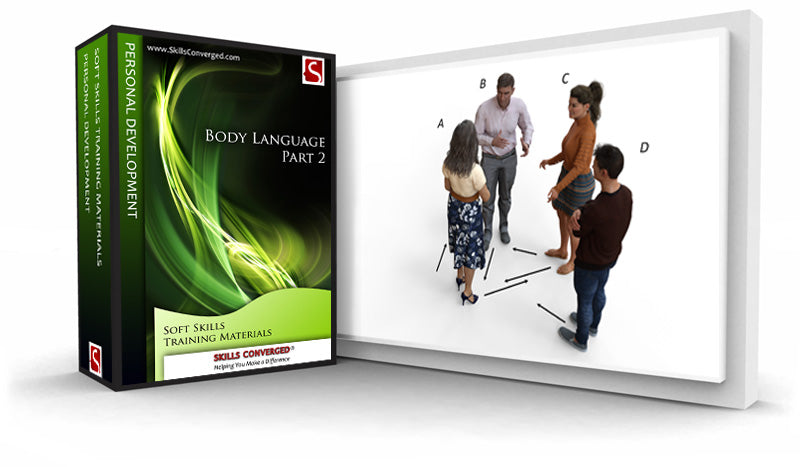
Public Speaking and Body Language
In today’s competitive world, being able to present an idea to an audience is a skill that no one can take lightly. If you haven’t done public speaking yet, eventually as you gain more experience and knowledge in your specific domain, there will come a time that you need to address an audience.
Many find public speaking daunting. For some, the fear is close to a phobia. However, public speaking is just a skill and like all skills, it can be mastered. You don’t have to be naturally gifted to do well; all you need to do it so to follow established guidelines and you will succeed.
When it comes to public speaking, most people’s first concern is how they are received. Will people laugh at them? Would the audience take them seriously? What happens if they forget what they have to say? What if something goes wrong? Fortunately, all of these fears can be addressed by practice before presenting to pubic. It turns out that a large factor in the success of a presentation is the presenter’s body language.
Consider the following example. One of the world’s best experts on bees needs to give a public presentation. She knows everything there is to know about bees. The problem is that she is so good at research that she would rather be with her bees than presenting. She doesn’t like public speaking nevertheless she has to do it anyway. During the talk, she talks quickly. She has a lot to say and wants to say it all. She stands behind the podium and talks in a monotone voice. She has a low voice which makes it difficult to understand. She doesn’t make any eye contact and is regularly looking at her slides on the wall when talking, facing away from the audience. She is holding a laser pointer which she fiddles with throughout the talk and points to the screen with a shaky hand. Her hair is in her face, covering one of her eyes. She pulls it aside once every minute.
Listening to such a presenter will be a chore. There will be so many distractions that no one could concentrate on the actual content of the talk, however ground breaking. Being a world expert doesn’t make you a good presenter, it is your public speaking skills along with good body language that allows you to deliver a compelling and engaging presentation or argument.
Here, you will find a number of guidelines that will help you improve your body language while presenting.
Be Presentable
Your audience will be looking at you more than anything else. Within your body they will be looking at your eyes most often followed by any part of your body that moves; lips, hands while gesturing or your whole body when you are moving around. Knowing this behaviour by your audience, you need to take full advantage of it.
- Dress based on the requirements of the presentation.
- Don’t wear distracting jewellery.
- Don’t wear bright colours that dominate or take the attention away.
- Choose cloth that is comfortable. No one wants to look at a person who is in agony for an hour.
- Wear lighter cloth than normal. While presenting you could get quite hot due to increased mental activity, stress or making energetic gestures. The last thing you want is to sweat in front of the audience. Adjust the temperature of the room before the audience arrives so that you feel comfortable.
Start Your Presentation Strongly
A presenter starts a presentation by stating his name. Then he looks at the laptop monitor in front of him and then back at the audience to state the title of the presentation. He then looks at his laptop monitor again and then he says which organisation he is from. He moves the slides forward and looks at the laptop monitor one more time before starting to talk about the main topic. What do you think of this performance?
Do you really need to look at your notes at the beginning of your presentation? Surely you will know your name, the title of your presentation and your organisation by heart. Why so many people start their presentations like this?
One of the reasons that presenters use repeated glances is that they feel nervous. It is the start of their presentation so they may have butterflies in stomach. Most presenters find looking at the notes a refuge, an opportunity to escape the intense gaze of an audience. This leads to a poor body language that may imply a lack of confidence and nervousness.
For public speaking, like all other performances, it is crucial to get the start right. Hollywood spends millions to get your attention in the first few minutes of a movie. Likewise any entertainment program worthy of its name starts with a bang. You should consider the same. Practice until you don’t have to find refuge in your notes and start your presentation by focusing on your audience as if you are about to talk with a group of people, not at them.
Use Gestures While Presenting to Public
Knowledge of body language and effective gesturing can help you improve your presentation skills or public speaking. An interesting study was conducted on three groups of people by restricting the amount of gesturing they could use; one group was free to use their hands during presentation, another group had one of their arms immobilised and a third group had both arms immobilised during a presentation (Finlayson et. al 2003). The research showed that there is a relationship between gesture and fluency. As gesture is restricted more, the fluency is decreased and the audience found it more difficult to understand the presenter.
Emphasise Your Points at the Right Level
Imagine a politician who is giving an interview to a journalist while being filmed by a cameraman. The politician is very passionate about the points she wants to make and while talking she uses the classic gestures made to stress a point; all fingers touching each other, pointing out straight and moving the hand up and down a few times. Now imagine if the politician uses this emphasising gesture uniformly and repeatedly throughout the entire 10-minute interview. Do you see a problem with this style? How would you feel about this performance as a viewer?
The audience understands that the politician wants to emphasise her points. That’s fair enough expect that if all points are going to be emphasised uniformly all the time, then the viewer would not know which points to pay more attention to. In other words, emphasising is meaningful only when it is relative. Something has to be stressed more often than others to stand out.
If you are giving a presentation, decide what is critical and more important and what is secondary and supportive. You must make this decision before giving a public talk. Sometimes this can be difficult as you may need to choose between a number of good points, but this is the nature of the game. For each presentation, ask yourself that if there was a single point you want your audience to take from you and your presentation, what that point would be. You can then fine tune your body language and use emphasising gestures when you are covering this point to clearly demonstrate what matters the most.
While emphasising, aim to vary your gestures. Don’t use the same habitual triple-chop movement every time you want to stress on something. Variety will make your presentation more pleasant and engaging, rather than repetitive and dull.
Use Gestures to Show Enthusiasm
Imagine a presenter who is hunched, doesn’t move, looks bored and speaks quietly. How would you feel about listening to such a presentation? Most probably, however interest you originally had in the subject, the unenthusiastic presentation would dampen your interest.
Enthusiasm is contagious. Lack of enthusiasm is contagious too, so you must be doubly careful about this when it comes to public speaking. As always, be mindful not go overboard with enthusiasm, otherwise you will look like an eager salesperson whose only interest is to sell and make money as opposed to satisfy a need or present an exciting solution to a problem.
Many surveys consistently show that audiences want to see passionate presentations. Use the following non-verbal signals to adjust your body language and show enthusiasm while speaking in public:
- Maintain eye contact. Nothing is more powerful than looking people in the eye to show that you are confident about what you are saying. Move your eyes from one person to another after stating a phrase or sentence. Make them feel as if you are talking directly to them. If done properly, you will get nods as you talk which means you are on the right track.
- Smile while you are presenting. Smiling is a great way to show enthusiasm and that you are happy to be here giving a presentation.
- Use hand gestures to stress the most critical points. Choose your critical topics wisely and before the presentation.
-
Orient your body towards the audience. It is important to be conscious of this especially if you need to show something on a screen or a whiteboard. Otherwise you end up facing the screen and talking away from the audience. This creates several problems:
- It breaks eye contact
- The audience can no longer read your lips reducing comprehension
- The direction of your voice changes, reducing its strength which can be problematic if you are not using a microphone.
- Your back is to the audience which is not always the best side to show!
- Move around. A static presentation is dull. A presenter that moves around appears to be energetic and the movement constantly engages the audience. You need to be careful not to overdo this. Too much moving around can distract and will have the opposite intended effect.
- Unclasp your hands. Don’t clasp your hand and hold them in front of your genitals! This non-verbal signal indicates unconscious protection of sensitive parts. Clasped hands are usually a sign of nervousness. Simply let your hands hang by your side. You may feel that it feels awkward, but that’s natural; they will look fine. Once you get into the flow of your presentation, your hands will join and match what you say as gesturing is a natural part of presenting and public speaking.
- Don’t put your hand in your pocket. It can be a sign of hiding something and prevents you from emphasising with your hands. It can also be distracting.
Maintain a Confident Posture
A confident posture suggests a confident claim. Use your body language to show how confident you are about what you are saying:
- Stand erect, don’t slouch
- Hold your chest slightly out and up
- Hold your chin up
- Keep both feet on the ground
- Don’t look down; look at your audience
- Don’t lean on a table
- Don’t lean against a wall
- Don’t stand while crossing your legs. Ladies must be particularly aware of this as this posture is commonly used by them.
- Don’t hold a podium with both hands as if you need to hold on to something or you will fall.
All of these signals suggest lack of confidence and show uncertainty. Avoid them at all costs.

Hands are crossed and hidden behind the podium. This is a defensive posture that indicates not being sure of a position or having something to hide
Don’t Talk Too Slowly or Too Fast
Suppose you are listening to a fast-talking presenter. This can be a salesman who wants to tell you everything there is to know about a product or it can be a cheap radio ad trying to maximise the text delivered in a small amount of time. You are likely to become suspicious. Most people associate fast talk with deception. The thinking goes like this; if a person is talking too fast, he is probably trying to distract me from realising the fallacy in his argument; therefor he must be trying to deceive me.
A typical audience is more likely to have problems with a fast talker than a slow talker. Even if you aim to speak slowly, you are likely to still speak faster than you should. So don’t be afraid that might slow down too much. Emphasise critical points, explain in different terms and in a clear voice. These days the chances are high that some members of your audience may have a different mother language than the one you use, so they would certainly appreciate your clear and slower speech.
People talk at an average rate of 125 to 225 words per minute. If a presenter talks at the upper range of this, listeners start to become very uncomfortable and may actively resist the speaker.
Remember, if you only have a short time to present, there is a temptation to squeeze as much information as possible and then talk as quickly as you can to cover it. This can be a mistake since your audience may react to your fast-talk by becoming suspicious of your core message. This is of course the last thing you want. Aim to talk slowly focusing on the core message. You would rather have an audience that fully understands one main point you cover than 10 half-explained half-understood points.
There is however always a flip side; do not speak too slowly! Research carried out by Paul Ekman on the rate of speech shows that slow speech riddled with long pauses, hesitation and injected with words such as “ah”, “uhh”, “aaa” can raise suspicion even more than fast talk.
These pauses and injected buffer sounds could be a sign that the person is working out how to lie to remain consistent or has forgotten a prepared line and is trying to remember or reconstruct it. Either way, the person’s body language makes you distrustful and the message will be rejected.
Understand Your Audience
Spend time looking at your audience to gauge if they are following you and if they are buying your argument. This allows you to see if you need to slow down in case they look confused or to speed up and skip material in case they look bored. This also helps you maintain eye contact. A presentation should always be customised based on a specific audience; there is no such thing as a general presentation that you can give to any audience. To present a customised presentation you need to know how your audience is reacting as you present it, which means you need to look at them and read their body language as you speak. The only exception to this is if you are giving a televised address, which is probably why it is many times harder to get right.
To read your audience’s body language, you need time. Buy time by speaking slowly or pause after describing something that is more involved than other topics. Your pause will serve several purposes; it helps break the monotony of your speech, it allows your audience to catch up with what you are saying and it allows you to see what they currently think of your presentation. You can then decide how to proceed and follow through.

Study your audience continuously
References
Finlayson S., Forrest, V., Lickley, R., Beck, J.M., (2003) “Disfluency in Spontaneous Speech”, Gothenburg papers in theoretical linguistics, Workshop No3, Göteborg , SUEDE (05/09/2003).

All Articles in the Series
A Comprehensive Guide to Body Language
Origins of Humans and Body Language
How to Read People Using Their Body Language
How to Influence Your Emotional State Using Body Language
Body Language Across Different Cultures
Body Language of Defensive Attitude
Body Language of Good First Impressions
How to Improve Personal Impact
Continue Reading the Body Language Series..
Body Language Guide Article IndexBody Language Training Materials
Body Language Exercises
Explore our collection of free body language training exercises and articles:



Use this body language exercise at the beginning of a session before covering non-verbal communication. The aim is to find out how much delegates already know about this topic and...
The aim of this exercise is to get the delegates think about body language and gestures and observe how such signals can be instrumental while communicating. The training exercise illustrates...
This is an exercise in communication with the aim to increase awareness of body language and non-verbal communications.







